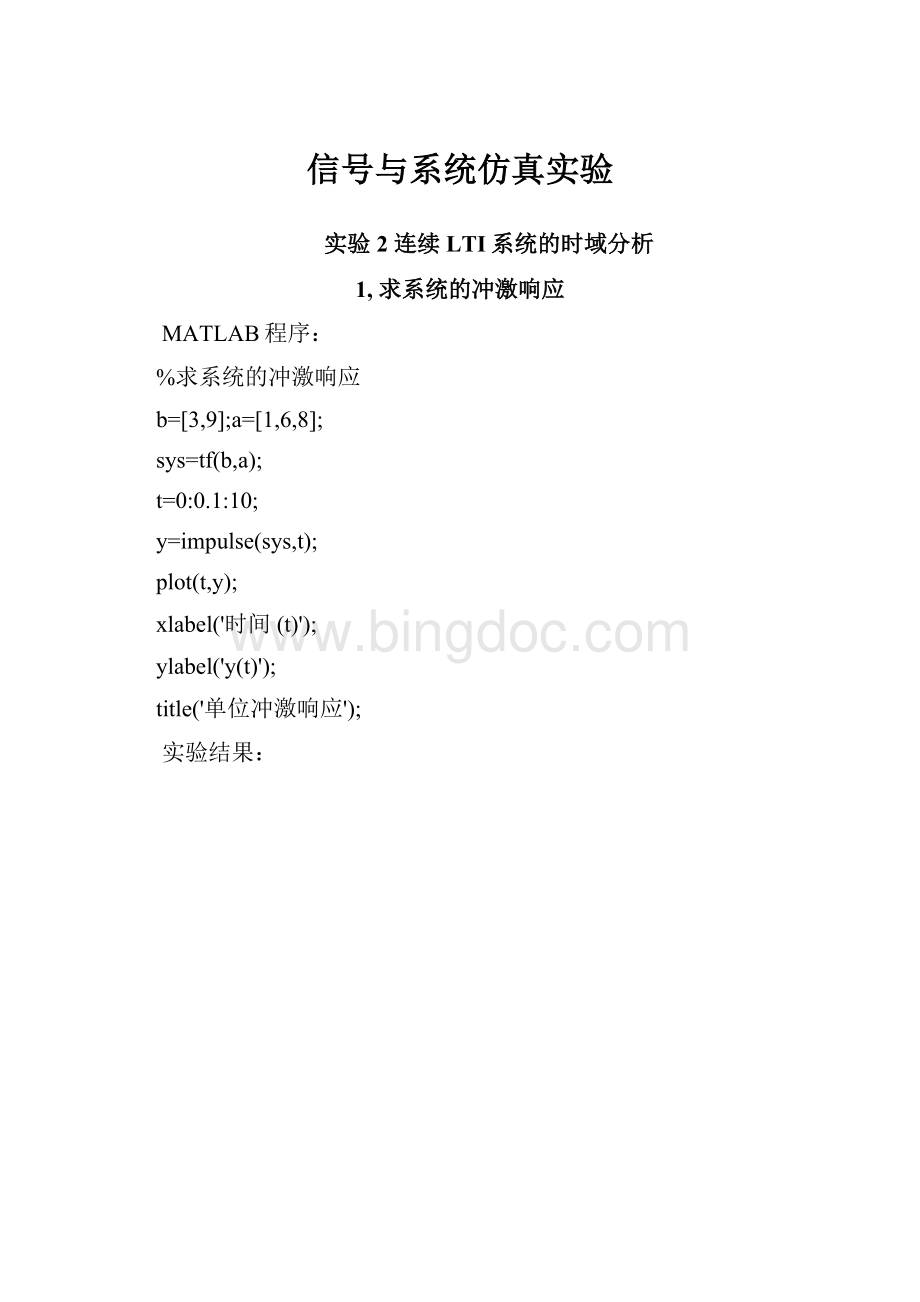信号与系统仿真实验.docx
《信号与系统仿真实验.docx》由会员分享,可在线阅读,更多相关《信号与系统仿真实验.docx(19页珍藏版)》请在冰点文库上搜索。

信号与系统仿真实验
实验2连续LTI系统的时域分析
1,求系统的冲激响应
MATLAB程序:
%求系统的冲激响应
b=[3,9];a=[1,6,8];
sys=tf(b,a);
t=0:
0.1:
10;
y=impulse(sys,t);
plot(t,y);
xlabel('时间(t)');
ylabel('y(t)');
title('单位冲激响应');
实验结果:
2,求系统的单位阶跃响应
MATLAB程序:
clearall;
b=[3,9];a=[1,6,8];
sys=tf(b,a);
t=0:
0.1:
10;
y=step(sys,t);
plot(t,y);
xlabel('时间(t)')
ylabel('y(t)');
title('单位阶跃响应’);
实验结果:
3,系统的正弦响应
MATLAB程序:
clearall;
b=[1];a=[1,0,1];
sys=tf(b,a);
t=0:
0.1:
10;
x=cos(t);
y=lsim(sys,x,t)
plot(t,y);
xlabel('时间(t)')
ylabel('y(t)');
title('正弦响应');
实验结果:
4,系统的零状态响应
MATLAB程序:
clearall;
b=[1];a=[1,0,1];
[A,B,C,D]=tf2ss(b,a);
sys=ss(A,B,C,D);
t=0:
0.1:
10;
x=cos(t);zi=[-1,0];
y=lsim(sys,x,t,zi);
plot(t,y);
xlabel('时间(t)')
ylabel('y(t)');
title('');
实验结果:
设计性实验1
(1)计算下述系统在指数函数激励下的零状态响应:
MATLAB程序:
clearall;
b=[1.65,-0.331,-576,90.6,19080];a=[1,0.996,463,97.8,121131,8.11];
sys=tf(b,a);
t=0:
0.0001:
10;
x=exp(t);
y=lsim(sys,x,t)
plot(t,y);
xlabel('ʱ¼ä(t)')
ylabel('y(t)');
实验结果:
设计性实验2:
(1)计算下述系统在冲激,阶跃,斜坡,和正弦激励下的零状态响应:
系统冲激响应:
MATLAB程序:
clearall;
b=[-0.475,-0.248,-0.1189,-0.0564];a=[1,0.6363,0.9396,0.5123,0.0037];
sys=tf(b,a);
t=0:
0.1:
10;
y=impulse(sys,t)
plot(t,y);
xlabel('时间(t)')
ylabel('y(t)');
title('冲激响应2')
实验结果:
阶跃响应:
MATLAB程序:
clearall;
b=[-0.475,-0.248,-0.1189,-0.0564];a=[1,0.6363,0.9396,0.5123,0.0037];
sys=tf(b,a);
t=0:
0.1:
10;
y=step(sys,t)
plot(t,y);
xlabel('时间(t)')
ylabel('y(t)');
title('阶跃响应2')
实验结果:
斜坡响应:
MATLAB程序:
clearall;
b=[-0.475,-0.248,-0.1189,-0.0564];a=[1,0.6363,0.9396,0.5123,0.0037];
sys=tf(b,a);
t=0:
0.1:
10;
x=t;
y=lsim(sys,x,t);
plot(t,y);
xlabel('时间(t)')
ylabel('y(t)');
title('斜坡响应')
实验结果:
正弦响应:
MATLAB程序:
clearall;
b=[-0.475,-0.248,-0.1189,-0.0564];a=[1,0.6363,0.9396,0.5123,0.0037];
sys=tf(b,a);
t=0:
0.1:
10;
x=cos(t);
y=lsim(sys,x,t);
plot(t,y);
xlabel('时间(t)')
ylabel('y(t)');
title('正弦响应')
实验结果:
实验3,连续LTI系统的频域分析
1,验证性实验1:
傅立叶变换:
MATLAB程序:
symst;
f=fourier(exp(-2*abs(t)));
ezplot(f);
实验结果:
验证性实验2:
试画出f(t)=2/3*e^-3t*U(t)的波形及其幅频特性曲线;
MATLAB程序:
symstvwf
f=2/3*exp(-3*t)*sym('heaviside(t)');
F=fourier(f);
subplot(2,1,1);
ezplot(f);
subplot(2,1,2);
ezplot(abs(F));
实验结果:
验证性实验3:
已知f(jw)=(1/(1+w^2),求信号F(jw)的逆傅立叶变换:
symstw
f=ifourier(1/(1+w^2),t);
ezplot(f);
实验结果:
ans=
(pi*exp(-t)*heaviside(t)+pi*heaviside(-t)*exp(t))/(2*pi)
验证性实验4:
傅立叶变换的时移特性:
MATLAB代码:
r=0.02;t=-5:
r:
5;N=200;Y=2*pi;k=-N:
N;w=k*Y/N;
f1=1/2*exp(-2*t).*stepfun(t,0);
F=r*f1*exp(-j*t'*w);
F1=abs(F);P1=angle(F);subplot(3,1,1);plot(t,f1);grid
xlabel('t');ylabel('f(t)');title('f(t)');subplot(3,1,2)
plot(w,F1);xlabel('w');grid;ylabel('F(jw)');subplot(3,1,3)
plot(w,P1*180/pi);grid;xlabel('w');ylabel('相位(度)');
实验结果:
设计性试验1
试验1
试确定下列信号的傅立叶变换的数学表达式:
(a)f(t)=U(t+1)-U(t-1)
MATLAB程序:
>>symstm
F=fourier(-heaviside(t-1)+heaviside(t+1))
F=
(1/exp(w*i))*(-pi*dirac(-w)+i/w)-exp(w*i)*(-pi*dirac(-w)+i/w)
(b):
symstm
F=fourier(exp(-3*t)*sym('heaviside(t-1)'))
F=
exp(-w*i-3)/(w*i+3)
(c)
symstm
F=fourier(exp(-1*t)*sym('heaviside(t-1)'))
结果:
symstm
F=fourier(exp(-1*t)*sym('heaviside(t-1)'))
(2)试画出f(t)=e^-3t*U(t),f(t-1)以及信号f(t)*e^-4jt的频谱图;
f(t)=e^-3t*U(t)的频谱图如下:
MATLAB程序:
r=0.02;t=-5:
r:
5;N=200;Y=2*pi;k=-N:
N;w=k*Y/N;
f1=1*exp(-3*t).*stepfun(t,0);
F=r*f1*exp(-j*t'*w);
F1=abs(F);P1=angle(F);subplot(3,1,1);plot(t,f1);grid
xlabel('t');ylabel('f(t)');title('f(t)');subplot(3,1,2)
plot(w,F1);xlabel('w');grid;ylabel('F(jw)');subplot(3,1,3)
plot(w,P1*180/pi);grid;xlabel('w');ylabel('相位(度)');
结果如下:
f(t-4)的频谱相移图MATLAB程序如下:
r=0.02;t=-5:
r:
5;N=200;Y=2*pi;k=-N:
N;w=k*Y/N;
f1=1*exp(-3*(t-4)).*stepfun(t,4);
F=r*f1*exp(-j*t'*w);
F1=abs(F);P1=angle(F);subplot(3,1,1);plot(t,f1);grid
xlabel('t');ylabel('f(t)');title('f(t-4)');subplot(3,1,2)
plot(w,F1);xlabel('w');grid;ylabel('F(jw)');subplot(3,1,3)
plot(w,P1*180/pi);grid;xlabel('w');ylabel('Ïà루¶È£©');
实验结果如下:
f(t)*e^-4jt的频谱图:
MATLAB程序如下:
r=0.02;t=-5:
r:
5;N=200;Y=2*pi;k=-N:
N;w=k*Y/N;
f1=1*exp(-3*(t-4)).*stepfun(t,0);f2=f1.*exp(-4*j*t);
F=r*f2*exp(-j*t'*w);
F1=abs(F);P1=angle(F);subplot(3,1,1);plot(t,f1);grid
xlabel('t');ylabel('f(t)');title('f(t)');subplot(3,1,2)
plot(w,F1);xlabel('w');grid;ylabel('F(jw)');title('F1(jw)');subplot(3,1,3)
plot(w,P1*180/pi);grid;xlabel('w');ylabel('Ïà루¶È£©');
实验结果如下:
信号f(t)*e^-4jt的频谱图:
MATLAB程序如下:
R=0.02;t=-2:
R:
2;
f1=exp(-3*t).*stepfun(t,0);f2=f1.*exp(-j*4*t);W1=2*pi*5;
N=500;k=-N:
N;W=k*W1/N;
F1=f1*exp(-j*t'*W)*R;
F2=f2*exp(-j*t'*W)*R;
F1=real(F1);F2=real(F2);subplot(2,1,1);plot(W,F1);
xlabel('w');ylabel('F1(jw)');title('ƵÆ×F1(jw)');
subplot(2,1,2);plot(W,F2);
xlabel('w');ylabel('F2(jw)');title('ƵÆ×F2(jw)');
实验结果如下: